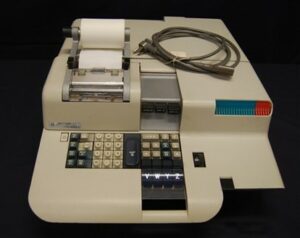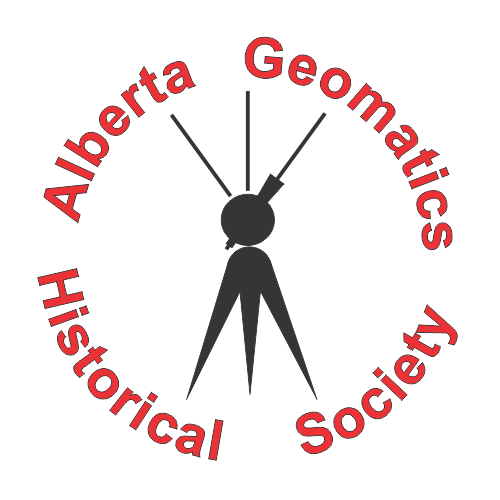
31. Every Surveyor’s Office Could Have a Computer – Desktop Computing
By Gordon Olsson
The first commercially available desktop computer was the Programma 101, released in 1965. It was made by Olivetti, an Italian company. The Programma 101 weighed around 65 pounds and was about the size of a typewriter. It had 37 keys, a decimal selector wheel, a built-in printer, and 240 bytes of internal memory. It could perform addition, subtraction, multiplication, division, and could also calculate square roots. It also had the ability to store programs on magnetic cards. Of interest it was used to perform calculations for the Apollo 11 moon landing and to calculate coordinates for B-52 bombing runs during the Vietnam War. An advertisement for a new Olivetti microcomputer, the P-652 in 1975 describes it as being 50 times faster than the P-101 which they state as the most widely used surveying microcomputer in the world.
Despite the success of the Programma 101, mainframe computing took over for adjusting large survey networks by federal, provincial and municipal government survey departments and many survey firms in the late 1960s and 1970s. See the previous article 30. Mainframe Computing in the 60’s and 70’s.
Mainframe computing for surveying applications soon came to an end as desktop computers became more powerful and affordable. Moore’s Law predicted that the number of transistors per silicon chip would double every year. 50 years later it was determined the doubling had actually occurred every 18 months, nevertheless remarkable. One university website states that a computer chip that contained 2,000 transistors cost $1,000 in 1970, $500 in 1972, $250 in 1974, and $0.97 in 1990 costs less than $0.02 to manufacture today.
In the early 1970s the introduction of competing products such as the Hewlett-Packard 9100 ended the Programma 101’s commercial life. The HP 9100A was advertised in 1969 at a cost of $5283.00. It was hyped as being able to store 196 program steps and being able to take about two minutes to do the same calculation that would take two hours in the traditional way using trig functions and a business calculator. In 1971 the HP 9100, with a surveyor’s program package, was advertised as being able to compute the closure error and enclosed area for an eleven-leg traverse in less than two minutes.
Eventually commercial software programs, such as GEOPAN and MicroSurvey, became available which could run on desktop PCs. These programs could perform coordinate geometry computations, least squares adjustments and data base management. AutoCAD (Computer Aided Drafting and Design) and GIS (Geographic Information Systems) such as Intergraph and Arc/Info further revolutionized computation and spatial data management.

Olivetti Programma 101 Computer. The Olivetti Programma 101 was used for survey calculation by only a few larger survey firms. It was priced at $3,200 (equivalent to $26,300 in 2020). This computer was used by McElhanney Survey Company which was founded in 1910 in Vancouver.
Donated by Dave McElhanney
ALSA 2010.02.01

Hewlett Packard HP 85 Computer. The HP 85 was introduced in 1980. It was a small, low-cost, fully integrated computer with built-in six-inch CRT display, tape drive and thermal printer. It had a storage capacity of 210K and came with 16K RAM, upgradeable to 32K. It was used by Dennis Woodhead ALS #209.
Donated by Jason Woodhead.
ALSA 2010.03.01
Sources of Information:
The Canadian Surveyor, Vol. XXIII, Annual Report 1969, No.4, page ix.
The Canadian Surveyor, Vol. 29, No 1, March 1975, page v.
Britannica, Moore’s Law.
University of Missouri, St. Lewis, Website: Moore’s Law.
Museum of Applied Science, Australia: https://collection.maas.museum/object/378406.
The Canadian Surveyor, Vol. XXIII, Annual Report 1969, No.3, page iv.
The Canadian Surveyor, Vol. 25, No 1, March 1971, page vii.
The Canadian Surveyor, Vol. 38, No 4, Winter 1984, pages ii, iii, x, xvi.
The Canadian Surveyor, Vol. 40, No 3, Autumn 1986, pages 329- 333.
Katherine Gordon, Maps, Mountains and Mosquitoes: The McElhanney Story, 1910-2010.
The Museum of HP Calculators: https://www.hpmuseum.org.
Author: Gordon Olsson, ALS (Hon. Life)
October 22, 2022
Copyright 2024 © Alberta Geomatics Historical Society
